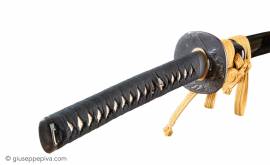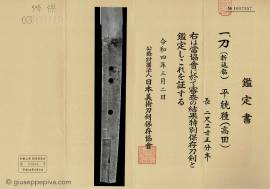Katana Shinto Bungo in koshirae
Taira Munetane (Takada)
Mei: [豊後高田住]平統種 [Bungo Takada ju] Taira Munetane
-
Early Edo Period (1615-1867), circa 1660-70
-
NBTHK Tokubetsu Hozon Tōken
-
Nagasa [length]: 71.3 cm
Sori [curvature]: 1.4 cm
Motohaba [bottom width]: 3 cm
Sakihaba [top width]: 2.2 cm
Motokasane [bottom thickness]: 7.6 mm
-
Sugata [configuration]: Shinogi-zukuri, iori-mune, shallow sori, chu-kissaki
Kitae [forging pattern]: Tight itame hada
Hamon [tempering pattern]: Ko-gunome midare in nioi-deki with kani no te, small hitatsura.
Boshi [point]: Midarekomi with large tobiyaki.
Nakago [tang]: Suriage, kirijiri, kiri-yasurime, orikaeshi-mei, three mekugi-ana
-
Origami [paper]: The blade comes with a Tokubetsu Hozon Tōken (Sword Particularly Worth of Preserving) certificate issued by the Nihon Bijutsu Token Hozon Kyokai
Koshirae [mounts]: The sword is accompanied by a good antique koshirae with high level fittings in iron, shakudo and gold.
Founded by Tomoyuki, the Takada school was active in the Bungo (Kyushu) from the Nanbokucho period through the Edo period. This school worked in both the Bizen and Mino traditions, as we can see from the features visible on this blade. Members of this school during the Shinto period are also known as Fujiwara Takada, as they used Fujiwara as a family name in their signatures. During the Muromachi period and the early Edo, swords from this school had a solid reputation as reliable weapons.
The orikaeshi mei bears the last part of the signature which would originally read Bungo Takada ju Taira Munetane. Orikaeshi mei is way to preserve the original signature when shortening the tang by bending it around to the opposite side, therefore leaving it upside-down.
Inventory Nr: 1741
Info works
Copyright © 2016 - giuseppe piva - VAT: 05104180962








